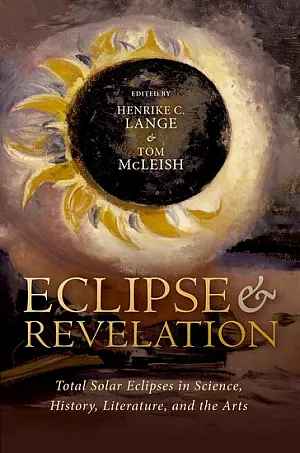Earth Sciences and Map Library
Pop-up Exhibit: Eclipse & Revelation: Total Solar Eclipses in Science, History, Literature, and the Arts
Eclipse & Revelation: Total Solar Eclipses in Science, History, Literature, and the Arts
In collaboration with the Earth Sciences & Map Library, Art History/Classics Library, Art History and Astronomy departments, this pop-up exhibit will feature maps and materials inspired by the April 8, 2024 Total Solar Eclipse and “Eclipse & Revelation,” a newly published book by Henrike Lange which shows total solar eclipses from the interdisciplinary perspectives of the sciences, arts, humanities, history, and theology.
Join us to explore the representation of eclipses through maps, images, music, and film.
More information, see the event calendar, https://events.berkeley.edu/Library/event/239296-eclipse-revelation-total-solar-eclipses-in, and the online guide: https://guides.lib.berkeley.edu/mapsandmore/eclipse2024
Eclipse & Revelation: Total Solar Eclipses in Science, History, Literature, and the Arts
Edited by: Henrike C. Lange and Tom McLeish
Exhibit organizers:
Henrike C. Lange, Associate Professor, History of Art department
Lynn Cunningham, Art Librarian
Sam Teplitzky, Open Science Librarian
Free large-format scanning for UC Berkeley students, faculty, and staff
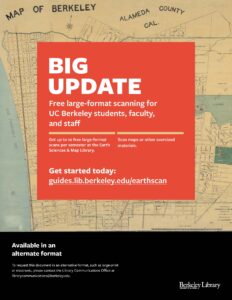 Members of the UC Berkeley community can now get up to 10 free large-format scans per semester at the Earth Sciences & Map Library! This can include maps or other large, flat materials. Scans over the free allotment are $10 each. For walk-in patrons not affiliated with the university, the cost is $25 per scan. Get more information about large-format scanning, or visit the library to start your scanning project.
Members of the UC Berkeley community can now get up to 10 free large-format scans per semester at the Earth Sciences & Map Library! This can include maps or other large, flat materials. Scans over the free allotment are $10 each. For walk-in patrons not affiliated with the university, the cost is $25 per scan. Get more information about large-format scanning, or visit the library to start your scanning project.Over 200 students “escape” the Earth Sciences and Map Library
For the third year in a row, we challenged undergraduates in Earth & Planetary Sciences and Geography courses to “escape” from the library by answering a series of questions related to the library’s platforms and services.
Over 200 students participated this year from September 1 – 30, 2023. At the conclusion of the contest, five winners were randomly drawn from eligible entries to receive prizes.

Try it!
Reading about something is never the same as a hands-on experience. The room remains open for visitors at the following link:
ENTER THE ESCAPE ROOM
The Escape Room is restricted to UC Berkeley affiliated students, staff and faculty. A “berkeley.edu” email address is required to participate.
History
Read about the creation of the 2021 Escape Room in this blog written by a member of the Earth Sciences & Map Library staff.
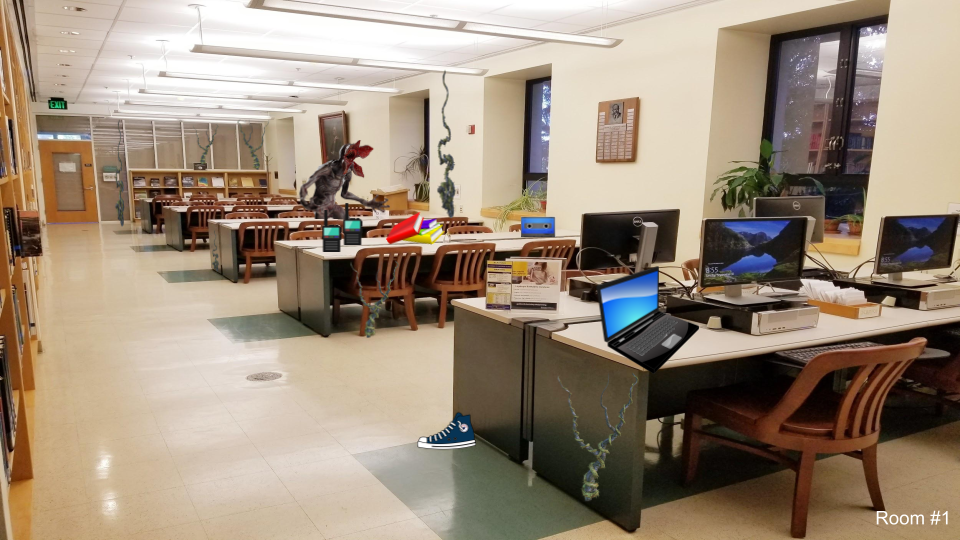
Updates & Audience
The 2023 Virtual Escape Room continues prior year’s Stranger Things theme with relevant updates to reflect changes in the library catalog as well as staffing and hours updates.
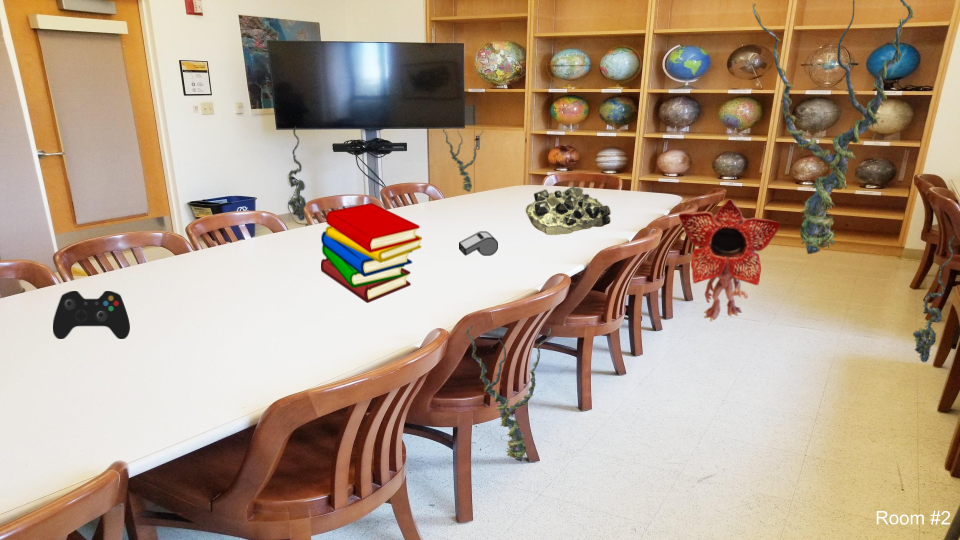
The Escape Room is open to all, but targets undergraduates taking EPS and Geography courses. In order to encourage camaraderie among departments housed within McCone Hall, affiliated students, faculty, and staff are encouraged to participate in the Escape Room’s simultaneous Battle of McCone competition. The main majors–Earth and Planetary Sciences and Geography–with the highest number of players will earn bragging rights as the winner of the friendly competition!
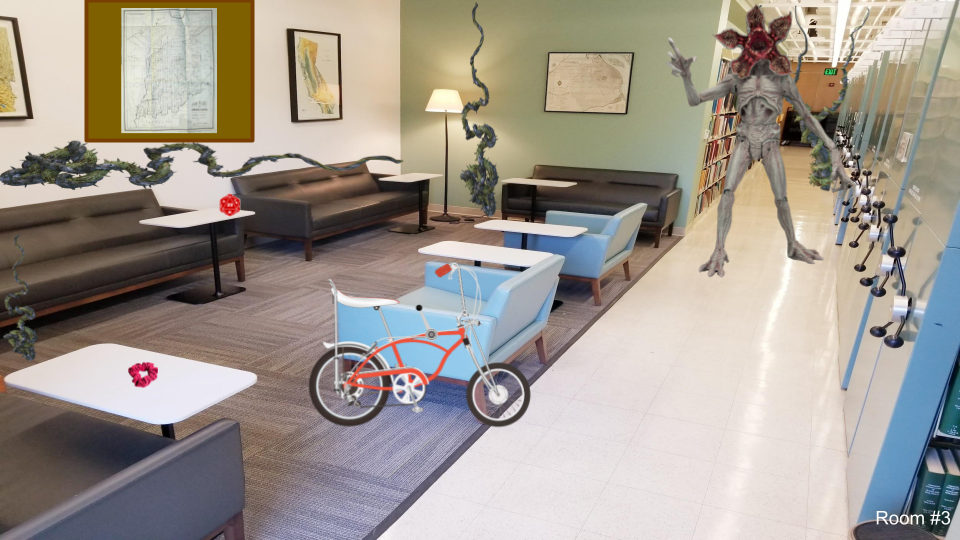
Questions?
We welcome questions and comments about the Earth Sciences & Map Library Virtual Escape Room. Email eart@library.berkeley.edu.
In Memoriam: Phil Hoehn (1941-2023)
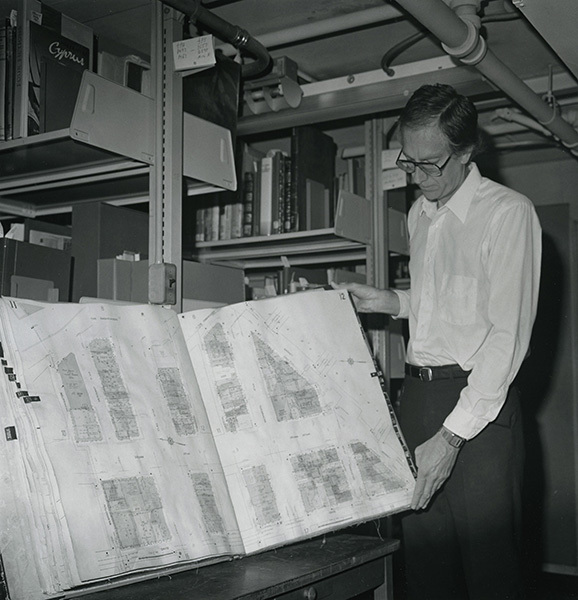
Longtime UC Berkeley Maps and Earth Sciences Librarian Phil Hoehn passed away on February 6, 2023, from complications of colon cancer. He was 81 years old.
Raymond Philip Hoehn, Jr. was born in Cape Girardeau, Missouri on October 23, 1941, the son of Raymond Philip Hoehn and Florentine Jeanne Hoehn. Following World War II, the Hoehn family moved west to southern California and Phil grew up in Pomona. Inheriting a love of maps from his grandfather, he majored in geography at UCLA. In 1967, Phil earned an MLS from UC Berkeley and began his career as the Map Librarian at UC Berkeley’s Bancroft Library in 1969. He was then asked to assume responsibility for the map collection of the General Library, and managed both collections for several years. When the Map Library was merged with the Earth Sciences map collection, Phil was tapped to lead the new combined unit, eventually known as the Earth Sciences and Map Library, and did so until his retirement in 1996.
Phil counted among his favorite accomplishments at Berkeley the development and management of the California Maps Project, an ambitious effort funded by a grant from the U.S. Department of Education to catalog and re-classify some 21,000 maps held in the collections of UC Berkeley and UCLA. Randal Brandt, currently Head of Cataloging at the Bancroft Library, was the project cataloger. “Phil hired me into my first professional position,” he recalled. “He mentored me, encouraged me, and supported me in the early years of my career. He also taught me how to catalog maps, which has been a part of nearly every job I’ve held since then. I can honestly say that I owe my professional career to Phil.”
One of the innovative decisions that Phil made during the project was to include geographic location data in records that describe California Land Case Maps. These diseños, rough manuscript maps, were used as evidence in the court cases which determined the validity of Spanish and Mexican land grants once California was ceded to the United States. Without the online tools of today, determining correct longitude and latitude data for the ranchos represented on the land case maps was not a simple task in the early 1990s.
Although this work was time-consuming, Phil’s decision paid huge dividends several years later when the Bancroft Library undertook the digitization of the maps. When discussing the significance of this metadata, Bancroft Interim Deputy Director Mary Elings, who directed the digitization project, noted the bridge that has been made between the handiwork of 19th century amateur cartographers and contemporary Geographic Information Systems in an important aspect of California history: “Adding the longitude and latitude to the Land Case Map records provided helpful information for researchers in geo-referencing the digitized historic maps, which in turn helps current researchers using GIS systems in their work.”
After he retired from Berkeley, Phil headed down the Peninsula and held the position of map bibliographer at Stanford University’s Branner Earth Sciences Library & Map Collections from 1996 to 2000. At Stanford he performed collection development and maintenance, provided reference assistance, and worked to promote university-wide awareness of the map collections and services. Subsequently, from 2000 until 2007 he served as consulting librarian at the David Rumsey Map Collection (now the David Rumsey Map Center at Stanford), where he created thousands of detailed catalog records for digitized maps.
Never one to spend much time “retired,” Phil then launched a second career as a volunteer map cataloger, first at the California Genealogical Society and then at the California Historical Society. In 2020, a CHS blog post described Phil’s work:
In June 2015, Phil Hoehn … took on the daunting task of organizing the California Historical Society’s vast map collection … over 45 drawers of flat sheet maps dating back to at least 1800 (including maps in atlases and books where cartographers depicted California as an island) as well as early mining, railroad, and irrigation maps, bound volumes of Sanborn Fire Insurance maps, and boxes of large rolled maps spanning all the counties in California. During the four years Phil worked reviewing, researching, cataloging, and rehousing the maps he discovered many unique titles, some that appear in only a few other collections in the world. Many of the works, by such prominent surveyors and cartographers as William Eddy, Herman Ehrenberg, Jasper O’Farrell, and August Chevalier, document the birth and growth of the city of San Francisco … [Phil] leaves nearly 4,000 maps now accessible to researchers. From foldout ones in rare books to enormous rolled maps that practically took a village to bring up from the vaults, Phil has discovered, cataloged, preserved, and documented them all.
Frances Kaplan, until recently Director of Library & Collections at the California Historical Society, expanded on Phil’s impact, saying “It is due to his efforts that the entire map collection at CHS is now cataloged and searchable. Along the way he discovered some rare ones and his work inspired the [current] map exhibit.” The exhibit, “Mapping a Changing California: From the Seventeenth to the Twentieth Century,” is on view through March 11, 2023.
Phil joined the Western Association of Map Libraries (WAML) in 1969, which was just two years after its first meeting took place. Phil was an active member of WAML his entire career. He found that the benefits of WAML membership included getting good practical advice from friendly, experienced colleagues. Phil also emerged as a wheeler and dealer who obtained many great maps for the UC Berkeley Library by participating in WAML duplicate exchanges. He viewed membership as a form of therapy and described WAML meetings as good places to voice local problems and concerns among like-minded individuals.
Phil had a direct hand in the founding of the California Map Society. Together with Diane M. T. North, who was then a Ph.D candidate at UC Davis, he co-convened a meeting at the Bancroft Library in May 1978, which was the inaugural gathering of the California Map Society. North recalled her long relationship with Phil: “Phil’s knowledge of and deep enthusiasm for maps, all maps, seemed boundless. Anyone privileged to have the opportunity to be guided by him and work alongside him benefited from his professionalism, patience, generosity, and quiet sense of humor.”
Phil had a longstanding interest in fire insurance maps, including local California maps, produced by the Dakin Publishing Company and he published on the subject. His most important publication, compiled together with William S. Peterson-Hunt and Evelyn L. Woodruff, is a reference tool of enduring value to map librarians and researchers, the Union List of Sanborn Fire Insurance Maps Held by Institutions in the United States and Canada, originally published in 2 volumes by the Western Association of Map Libraries in 1976-1977. The Earth Sciences and Map Library maintains an updated online version on its website which documents Phil’s hard work.
Together with UCSB map librarian Mary Larsgaard, Phil also co-authored a reference resource which historically has been useful to map librarians, the Dictionary of Abbreviations and Acronyms in Geographic Information Systems, Cartography, and Remote Sensing.
Will Murdoch, a book cataloger at the California Historical Society, who worked with Phil from 2015 until 2019, shared his memories of Phil:
He was my mentor and work colleague in the CHS Library. I cataloged books and Phil processed the maps in that collection. We shared a lot of fun discoveries with each other and learned about the depth of the CHS archives. It was an education for me as Phil’s background was extensive and he was so kind to share his knowledge with me. I miss him and our work together there.
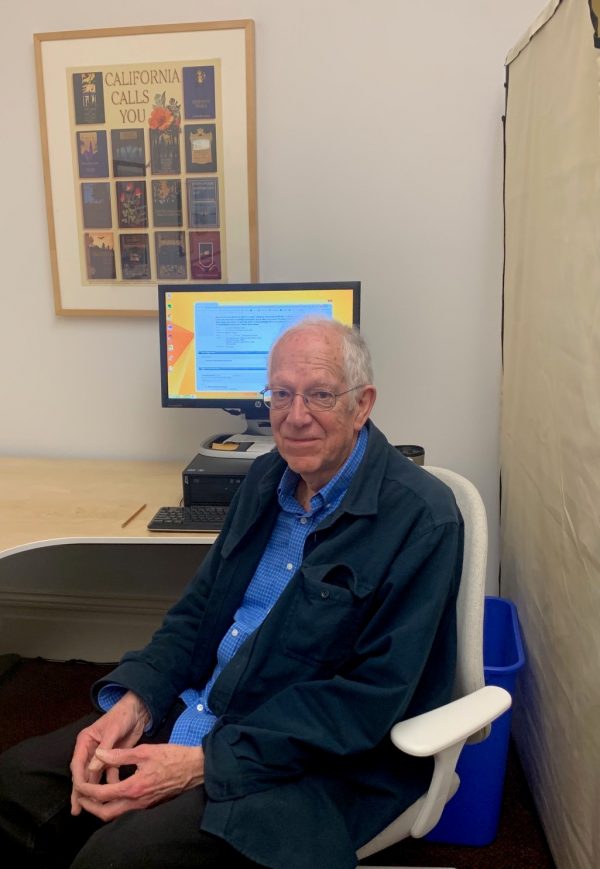
Phil Hoehn played an important role in building the rich and diverse map collections on the Berkeley campus. As a map librarian, map bibliographer, metadata specialist Phil was instrumental in providing expert resource discovery for cartographic resources at many institutions throughout the Bay Area. More important than his professional qualities, however, Phil excelled as a colleague, mentor, and friend. Everyone who knew him and worked with him was made better for the experience.
Randal S. Brandt, Bancroft Library
Heiko Mühr, Earth Sciences & Map Library
Susan Powell, Earth Sciences & Map Library
Lines of Latitude: Putting Ukraine on the map (and keeping it there)
In the 16th century, Western European Renaissance cartographers treated the Ukrainian lands as a peripheral place. Initially, Ukraine’s territory appeared only on maps that covered much larger geographical frames, such as Central Europe, Eastern Europe, or the Black Sea region. These early maps still privileged classical sources which had provided descriptions of the area, notably Herodotus, who had authored a detailed account of the Scythian lands north of the Black Sea. Other classical authors, including Ptolemy, Strabo, Pliny the Elder, and Tacitus, covered a later period when the Sarmatians, a confederation of Eastern Iranian nomadic peoples, moved westward and, by 200 BCE, began to dominate the Scythians. Their control of the Pontic Steppe brought the Sarmatians into contact with Greek and Roman communities.
In 1477, Dominicus de Lapis published the first illustrated edition of Ptolemy’s Geography, translated by the humanist Giacomo d’Angelo da Scarperia, in Bologna, Italy. Its 26 plates, which had been engraved by Taddeo Crevilli of Ferrara, included the map “European Sarmatia,” the first printed map to cover Ukrainian territory. The prestige of Ptolemy’s Geography meant that the sheets showing “European Sarmatia” and “Asian Sarmatia” continued to be standard fare for some time.
Sebastian Münster (1489-1552), Lutheran theologian, Hebrew scholar, mathematician, cartographer, and cosmographer, published four editions of Ptolemy’s Geography in his lifetime. His Geographia universalis vetus et nova (1540), printed in Basel, Switzerland, included “Tabula Europae VIII,” a map of Eastern Europe in trapezoidal form with pictorial relief, essentially Münster’s version of the sheet “European Sarmatia.” All geographical names on this map are drawn from the classical sources which Renaissance scholars prized. Rivers which dissect the Ukrainian lands are thus identified as Tyras (Dniester), Hypanis (southern Bug), Borysthenes (Dnipro or Dnieper), and Tanais (Don).
However, Münster’s 1540 edition of Ptolemy’s Geography did not contain just the Ptolemaic maps. It also featured 21 modern maps, which Münster himself had produced. Münster subsequently added new plates each time he issued a revised edition of his Geographia universalis. The 1552 edition also featured a contemporary map of Poland and Hungary, “Polonia et Ungaria, XX Nova Tabula,” based on information gleaned from the work of the Polish cartographer Bernard Wapowski (ca. 1450-1535). The Ukrainian lands west of the Dnipro (or Dnieper) River are here identified with regional labels as Russia, Volhinia, Podolia, Codimia, and Bessarabia.
Münster uses the geographical name Russia to identify the westernmost part of Ukraine, the lands of the Ruthenian domain of the Polish Crown, the Ruthenian Voivodeship. Historically this area was part of the territory of the Principality of Galicia-Volhynia (1199-1253) of the Kyivan Rus, and later the historic core of its successor, the Kingdom of Ruthenia (1253-1349). It was subsequently conquered by Lithuanians and Poles. Other Ukrainian lands west of the Dnipro River with Kyovia (= Kyiv) are shown as parts of Lithuania, within its yellow border. By contrast, the lands east of the Dnipro River are identified as Tartaria Precopien (Crimea) and Tartaria Minor, regions controlled by the Crimean Tatars. Moscovia appears in the upper eastern margin of the map, within the green border which demarcates the Tatar sphere of influence. It is shown as a territory which historically paid tribute to the Golden Horde.
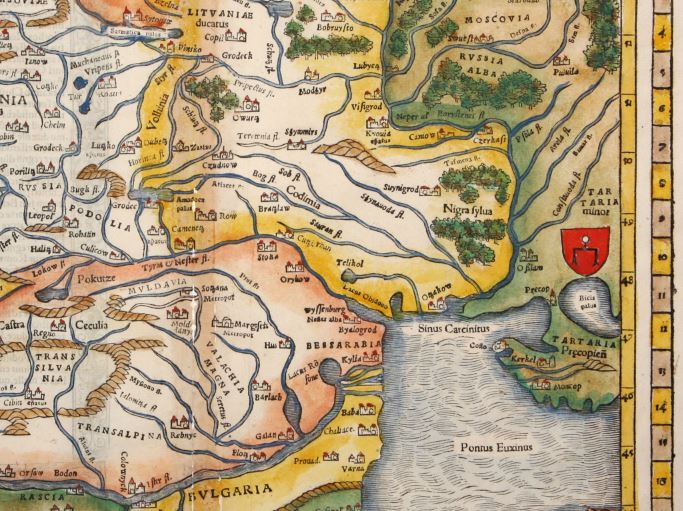
The western Ukrainian cities of Leopol (Lviv) and Halitz (Halicz), important medieval centers, are shown in the left margin next to the geographical name Russia. Münster‘s Polonia et Ungaria, XX Nova Tabula thus identifies Russia as the territory of the Kingdom of Poland’s Ruthenian Voivodeship, which existed from 1434 to 1772.
In the right margin appears the emblem of the Golden Horde (also known as Ulug Ulus, literally “Great State” in Turkic), initially the northwestern part of the Mongol Empire, later transformed into a Turkicized khanate. In the 16th century “Tartaria” was controlled by the Crimean Khanate, a successor state of the Golden Horde. This is also a device that enbles Münster to show that the Ukrainian lands were contested borderlands.
In 1618, after the Truce of Deulino, most Ukrainian lands were situated within the Polish-Lithuanian Commonwealth, but social and political crises gradually eroded its power base. Other powers tried to assert control over parts of the borderlands, including Czarist Russia, the Austrian Habsburgs and the Kingdom of Hungary, the Ottoman Empire, and the Crimean Khanate. Cossack hosts, self-governing groups of Eastern Slavic Orthodox believers, communities with military forces, grew in size, and more aggressively pursued their own interests, notably the Zaporozhian Cossacks, who established the Cossack Hetmanate.
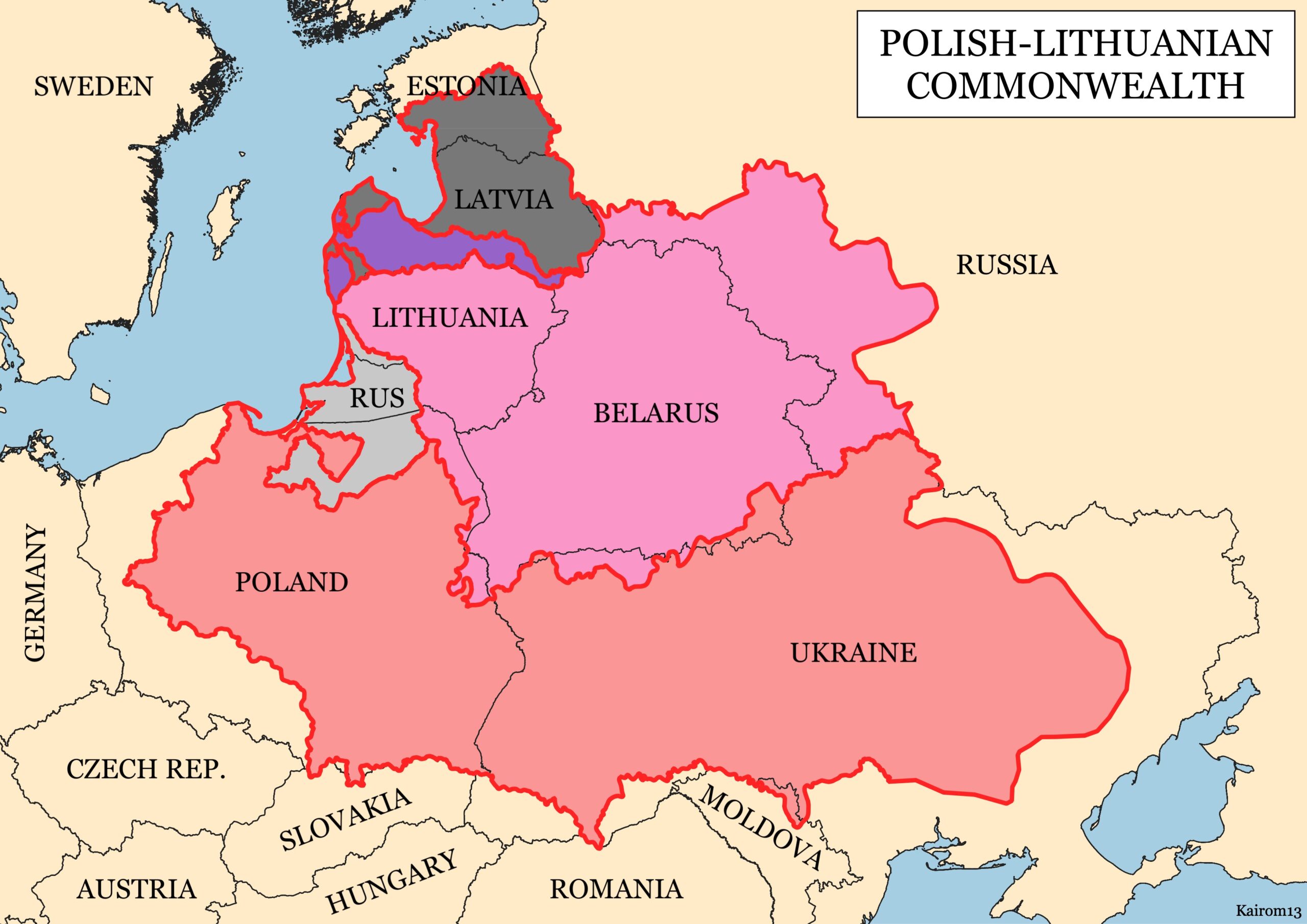
In 1613, the geographical name “Ukraina” appeared for the first time on a printed map, Magni Ducatus Lithuaniae, caeterarumque regionum illi adiacentium exacta descriptio, in English translation The Grand Duchy of Lithuania and the Surrounding Regions with Their Exact Description. This celebrated wall map, commonly identified as the Radziwiłł (or Radvila) map, has a complicated publication history: About 1585 Prince Mikołaj Krzysztof Radziwiłł (1549–1616), also known as Mykalojus Kristupas Radvila, a powerful Lithuanian magnate, commissioned Maciej Strubicz (1530-1604), a notable Polish cartographer, to produce a map of the entire Lithuanian state. Radziwiłł saw a need for an accurate map, which could be used as an efficient planning tool for administrative and military matters. He was also interested in documenting the boundaries and heritage of the old Lithuania, which had been obliterated by the Union of Lublin (1569). The Union’s political settlement had created a single state, the Polish-Lithuanian Commonwealth, both politically and culturally dominated by its Polish core.
Strubicz had served as secretary and geographer to Stephen Báthory, King of Poland and Grand Duke of Lithuania. He had drawn an important military campaign map, which aided Polish and Lithuanian forces in the final stages of the Livonian War (1577-1582), when they faced off against the Muscovite army of Ivan IV “the Terrible.” Báthory managed to force a settlement which excluded the Grand Duchy of Moscow from access to the Baltic Sea. For his services, Strubicz was subsequently ennobled in Warsaw in 1583. This map covered Livonia, as well as parts of the Grand Duchy of Lithuania and the Grand Duchy of Moscow. An improved version was published in Cologne, Germany, in 1589, by Marcin Kromer under the title Magni Ducatus Lithuaniae, Livoniae et Moscoviae descriptio.
Radziwiłł, who was nicknamed “Sierotka” [the orphan] to distinguish him from other members of the princely Radziwiłł family, served as Great Marshal of Lithuania (1579–1586) and Voivode of Trakai-Vilnius (1604–1616). He was a powerful man with connections and considerable means at his disposal. For years, he funded Strubicz’s work and provided support from others who gathered at Nesvizh Castle, the residential estate of the Radziwiłł family, today located in Niasviž, Belarus.
Strubciz’s diligent efforts greatly improved the mapping of this large section of Eastern Europe. He skillfully mined data derived from inventories, surveys, and terrain measurements. Many of these sources were produced during the Volok reform, a 16th-century land reform which led to an increase in crop yields and state revenue. The Volok reform strengthened the manorial system in Lithuania, but the reforms also reduced many Lithuanian peasants to serfdom. Land holdings were measured, divided into voloks, land units of about 52.8 acres, and entered into a cadaster, a detailed, official record of real estate boundaries, ownerships, and land values of a specific area.
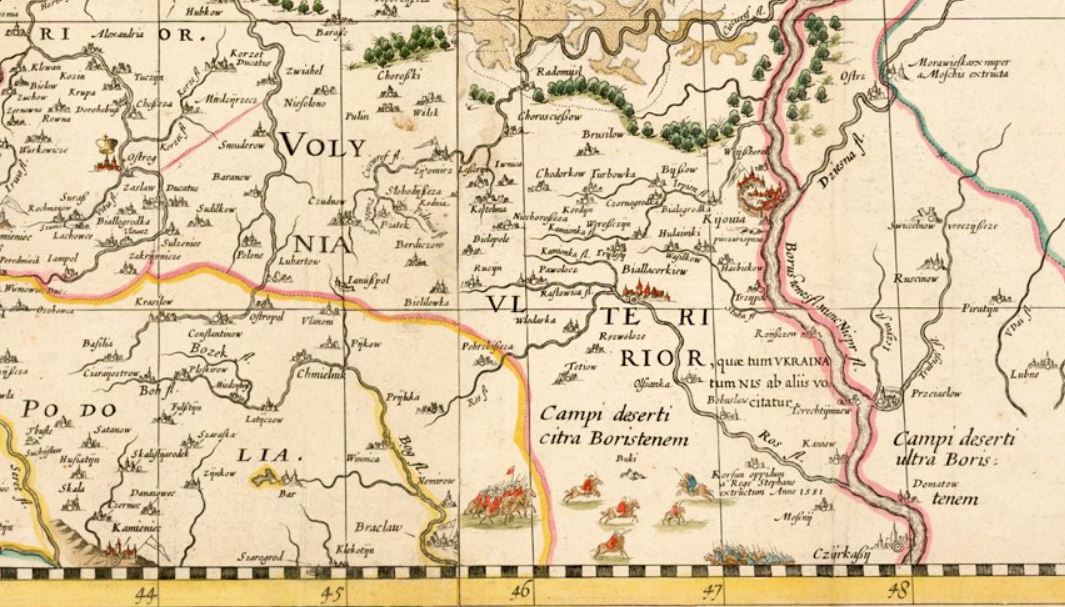
Roaming bands of Cossacks and Crimean Tatars are shown at the bottom of the Radziwiłł map of 1613, facing off against each other in the “deserted plains.” Historians like Bohdan S. Kordan, Steven Seegel, and Serhii Plokhy have long emphasized the central role Cossacks played in popularizing the geographical name Ukraine in the 17th century. Europeans identfied Ukraine as the “Land of the Cossacks.”
The map covers a vast region, stretching from Riga to Smolensk in the north, and from Cracow to Kyiv in the south. It locates 1,020 cities, towns, and villages, and very precisely maps water features throughout this vast region. It shows political and administrative boundaries, including a line which divides the ancient Grand Duchy of Lithuania in half and closely mirrors the present-day Ukrainian-Belarusian border. The region west of Kiova (Kyiv) is identified as “Volynia Ulterior, quae tum Ukraina tum Nis ab aliis volcitatur,” in English translation “Outer Volhynia, known either as Ukraine or as the Dnipro River Region.” The geographical name “Ukraina” thus describes part of the lands in the south, centered on the right bank of the Dnipro River. “Ukraina” roughly extends from Kyiv in the north to Cherkasy in the south. Strubicz identifies an area west of Cherkasy as wild steppe, “Campi deserti citra Boristenem,” in English translation “Deserted plains on this side of the river Borysthenes.”
Also included are historical notes and explanatory text, compiled by Tomasz Makowski (1575–circa 1630), a printer, artist, and engraver, who worked at the court of Prince Radziwiłł at Nesvizh Castle and also played an important role in preparing the map for publication. The English Jesuit mathematician Jacob Bosgrave was also a contributor. The Voivode of Kyiv, the Ruthenian Orthodox magnate Konstanty Wasyl Ostrogski (also known as Prince Kostiantyn Vasyl Ostrozkyi) and Józef Wereszczyński, Catholic bishop of Kyiv, provided cartographic data about the Ukrainian lands.
Prince Radziwiłł now contacted the Dutch map publisher Willem Janszoon (Blaeu) (1571–1638), famous for the manufacture of globes and wall maps, for publication of his map. Hessel Gerritsz (1581–1632), a Dutch cartographer of Blaeu’s publishing house in Amsterdam, engraved the plates, and, in 1613, Blaeu published the wall map in four sheets, under the imprint “Guilhelmus Janssonius.” He also published a related strip map of Ukraine’s Dnipro River region from Cherkasy to its Black Sea estuary on two additional sheets. Following the course of the river, the map describes the Dnipro rapids, local salt mines, towns and villages, and fortifications, and also includes notes about Cossack traditions. Blaeu eventually emerged as a noted publisher of atlases, and featured the Radziwiłł map in his Appendix Theatri A. Ortelii et Atlantis G. Mercatoris, continens tabulas geographicas diversarum Orbis regionum, nunc primum editas cum descriptionibus in 1631. The map subsequently appeared in other atlas editions through 1670.
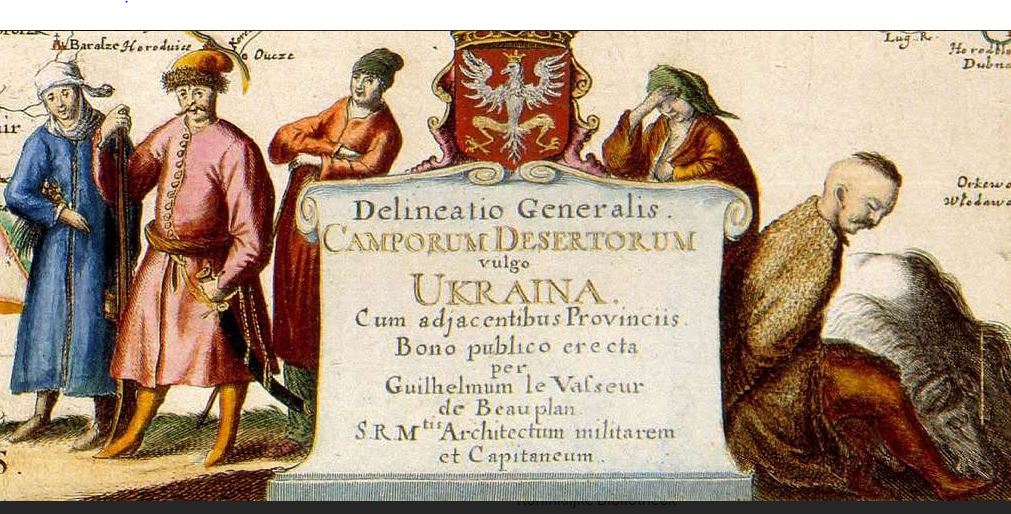
One cartographer who recognized the significance of the Radziwiłł map was Guillaume le Vasseur de Beauplan (1600-1673), a French military engineer, who served for two decades in the army of the Polish-Lithuanian Commonwealth, starting in 1630. Beauplan was initially charged with identifying suitable sites for the construction of fortifications in Ukraine. Later he planned settlements, and built or enlarged fortresses. Beginning in 1648, Beauplan turned his attention to the map trade. He published a general map of Ukraine, in 1650 followed by a special map of the same area on eight sheets, engraved in the workshop of the Dutch cartographer and map publisher Willem Hondius (de Hondt) in Gdansk.
In 1660, the Carte d’Ukranie, contenant plusieurs provinces comprises entre les confins de Moscovie et les limittes de Transilvanie, a Beauplan map published in Rouen, France, by Jacques Cailloue, boldly demarcated the boundaries of Ukraine. That same year Cailloue also published a second, enlarged edition of Beauplan’s popular Description d’Ukranie (Rouen, 1660). A third edition followed in 1661. In his writings and on his maps Beauplan carefully noted the geographical naming practices of the inhabitants of the Ukrainian lands. His decision to identify the vast region located between Transylvania and Muscovy as Ukraine reflects 17th century Cossack usage.
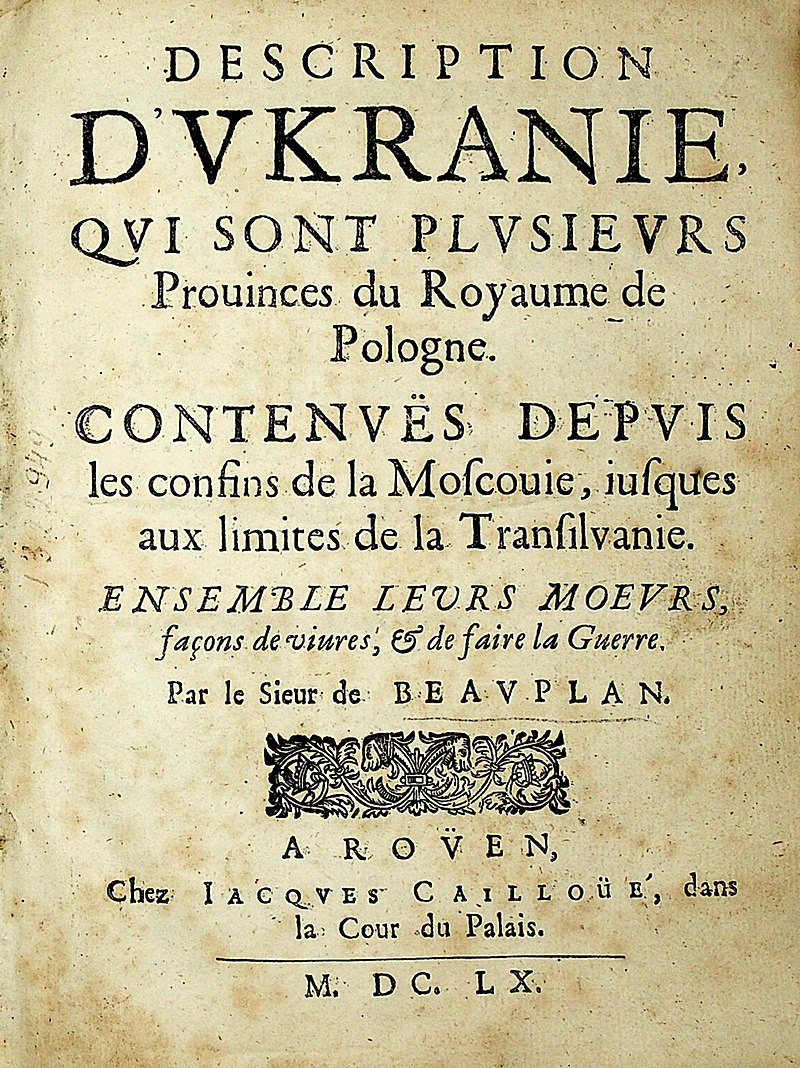
Beauplan’s maps were subsequently incorporated in Blaeu’s Atlas major (1659-72) and appeared in the 1680s in influential atlases published by Johannes Janssonius and Moses Pitt. Other cartographers now treated Beauplan’s work in Eastern Europe as authoritative, and continued to see Ukraine as “Land of the Cossacks.” For the next century and a half cartographers faithfully reproduced Beauplan’s maps in atlas compilations. Beauplan thus played a crucial role in helping to codify the usage of the geographical name “Ukraine,” for a large defined territory.
Suggested readings:
Buczek, Karol. The History of Polish Cartography from the 15th to the 18th Century. 2nd edition. Amsterdam: Meridian Publishing Company, 1982.
Kordan, Bohdan S. Land of the Cossacks: Antiquarian Maps of Ukraine. Winnipeg: Ukrainian Cultural and Educational Centre, 1987.
Kordan, Bohdan S. The Mapping of Ukraine: European Cartography and Maps of Early Modern Ukraine, 1550-1779. New York: The Ukrainian Museum, 2008.
Magocsi, Paul R. Historical Atlas of Central Europe. 3rd edition. Toronto: University of Toronto Press, 2018.
Plokhy, Serhii. The Gates of Europe: A History of Ukraine. Revised edition. New York: Basic Books, 2021.
Plokhy, Serhii. “Placing Ukraine on the Map of Europe.” In The Frontline: Essays on Ukraine’s Past and Present, 15-36. Cambridge, MA: Harvard Ukrainian Research Institute, 2021.
Seegel, Steven. Ukraine under Western Eyes: The Bohdan and Neonila Krawciw Ucrainica Map Collection. Cambridge, MA: Harvard Ukrainian Research Institute, 2011.
Coming Soon: Love Your Data, from Editathons to Containers!
UC Berkeley has been loving its data for a long time, and has been part of the international movement which is Love Data Week (LDW) since at least 2016, even during the pandemic! This year is no exception—the UC Berkeley Libraries and our campus partners are offering some fantastic workshops (four of which are led by our very own librarians) as part of the University of California-wide observance.
Love Data Week 2023 is happening next month, February 13-17 (it’s always during the week of Valentine’s Day)!
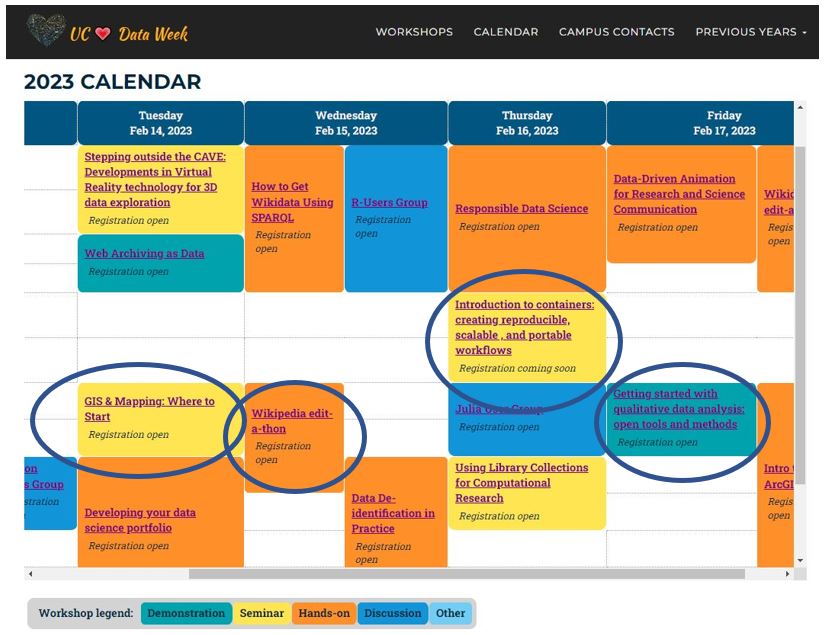
UC Berkeley Love Data Week offerings for 2023 include:
Wikipedia Edit-a-thon (you can also dip into Wikidata at other LDW events)
Textual Analysis with Archival Materials
Getting Started with Qualitative Data Analysis
All members of the UC community are welcome—we hope you will join us! Registration links for our offerings are above, and the full UC-wide calendar is here. If you are interested in learning more about what the library is doing with data, check out our new Data + Digital Scholarship Services page. And, feel free to email us at librarydataservices@berkeley.edu. Looking forward to data bonding next month!
Seismica is live!
As Open Science Editor of Seismica, a new diamond open access journal in Seismology and Earthquake Science, I’m pleased to share that Seismica is live!
The root of the Galapagos hotspot plume is as wide as Ecuador, according to Cottaar et al. They mapped it using data from Chilean earthquake waves traveling along the core-mantle boundary.
Read Seismica's 1st published article 🎉🥳: https://t.co/3jCweB07lt#DiamondOpenAccess pic.twitter.com/ZdUxgl5jnB
— Seismica (@WeAreSeismica) October 28, 2022
Our first article by Sanne Cottar et al. was published today.
For the open science enthusiasts out there, this paper does it all!
- Data availability ✅
- Code sharing ✅
- Author contributions ✅
- Public peer review ✅
This paper was free for the authors (no APCs) and is free to read, the first of many in the pipeline at Seismica.
Lines of Latitude: How historic maps tell the story of Ukraine
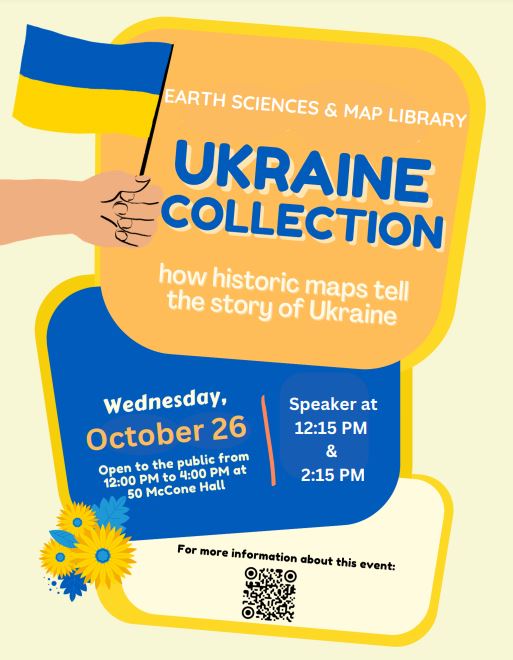
Please join us for a Maps & More program at the Earth Sciences and Map Library in McCone Hall, located near North Gate on the UC Berkeley campus, on Wednesday, October 26th.
Professor John Connelly (Director, Institute of Slavic, East European, and Eurasian Studies) will introduce a temporary exhibit of historic maps of Ukraine with brief remarks at 12:15 PM and 2:15 PM. Dr. Connelly, a specialist in East European history, currently teaches a course “Ukraine and Its Neighbors.”
Highlights from the library’s collection of Ukrainian, Central European and East European maps and atlases will be on display throughout the afternoon, from noon to 4 PM.
European Renaissance cartographers treated Ukraine as a peripheral place. That changed in the 17th century, in part due to work done by Guillaume le Vasseur de Beauplan (1600-1673), a French military engineer and cartographer, who served for two decades in the army of the Polish-Lithuanian Commonwealth, starting in 1630.
Beauplan was initially charged with identifying suitable sites for the construction of fortifications in Ukraine. Later he planned settlements, and built or enlarged fortresses. Beginning in 1648, Beauplan turned his attention to the map trade. He published a general map of Ukraine, followed by a special map of the same area on eight sheets, engraved in the workshop of the Dutch cartographer and map publisher Willem Hondius (de Hondt) in Gdansk, Poland.
 A decorative cartouche, from the map General Depiction of the Deserted Plains, Commonly Identified as Ukraine, Together with its Neighboring Provinces (Gdansk, Poland, 1648), drawn by Beauplan, who had crisscrossed the territory of the Polish-Lithuanian Commonwealth and the lands of the Cossack Hetmanate on military campaigns against Cossacks and Crimean Tatars and travelled throughout much of what today constitutes Ukraine.
A decorative cartouche, from the map General Depiction of the Deserted Plains, Commonly Identified as Ukraine, Together with its Neighboring Provinces (Gdansk, Poland, 1648), drawn by Beauplan, who had crisscrossed the territory of the Polish-Lithuanian Commonwealth and the lands of the Cossack Hetmanate on military campaigns against Cossacks and Crimean Tatars and travelled throughout much of what today constitutes Ukraine.
In 1660, a Beauplan map published in Rouen, France, by Jacques Cailloue, the Carte d’Ukranie, contenant plusieurs provinces comprises entre les confins de Moscovie et les limittes de Transilvanie, boldly demarcated the boundaries of Ukraine. That same year Cailloue also published a second, enlarged edition of Beauplan’s popular book Description d’Ukranie (Rouen, 1660). A third edition followed in 1661. In his writings and on his maps Beauplan carefully noted the geographical naming practices of the indigenous inhabitants which he encountered in these borderland areas. His decision to identify the vast region located between Transylvania and Muscovy as Ukraine reflects 17th century Cossack usage.

Maps that Beauplan produced were subsequently incorporated in Johannes Blaeu’s Atlas major (1659-72) and appeared in the 1680s in influential atlases published by Johannes Janssonius and Moses Pitt. Other cartographers now treated Beauplan’s work in Eastern Europe as authoritative and continued to see Ukraine as “Land of the Cossacks.” For the next century and a half other cartographers faithfully reproduced Beauplan’s maps in atlas compilations. Beauplan thus played a crucial role in helping to codify the usage of the geographical name “Ukraine” for a large defined territory.
Most of the maps and atlases in the collections of the Earth Sciences and Map Library cover Ukraine and associated larger frames of geographical reference, like the Black Sea region, Central Europe, or Eastern Europe in the late 19th and 20th centuries. Some were produced by the murderous regimes which sought to dominate Ukraine and its neighbors.
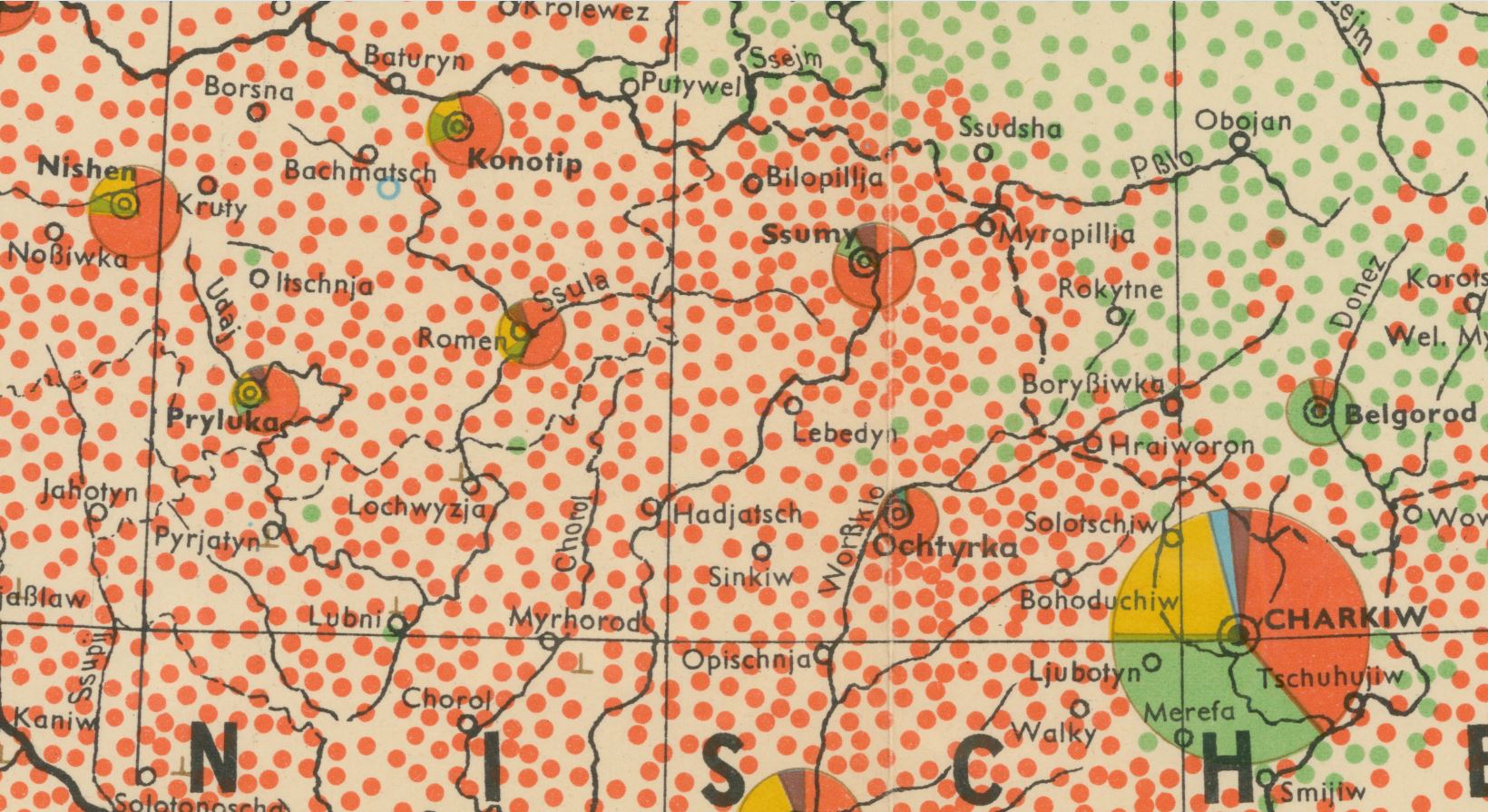 The Kharkiv region, detail from an ethnographic map of the Ukrainian S.S.R. based on the 1926 census of the Soviet Union. That census took place when Ukrainians were still free to express ethnic preferences, before the Stalinist repression, the Holodomor (the Terror-Famine of 1932-1933), and before Nazi Germany invaded the area and murdered millions of Ukrainians during World War II. In 1926, the countryside appears solidly Ukrainian. Most cities have sizable Jewish communities, in particular Kharkiv. Image source: Nationalitätenkarte der Ukraine (Berlin, 1943), from Atlas der Ukraine und benachbarten Gebiete, a loose-leaf atlas published by a Nazi Ostforschung Institute. Digitized by the UC Berkeley Library, as part of its ongoing German World War II Captured Maps digitial humanities project.
The Kharkiv region, detail from an ethnographic map of the Ukrainian S.S.R. based on the 1926 census of the Soviet Union. That census took place when Ukrainians were still free to express ethnic preferences, before the Stalinist repression, the Holodomor (the Terror-Famine of 1932-1933), and before Nazi Germany invaded the area and murdered millions of Ukrainians during World War II. In 1926, the countryside appears solidly Ukrainian. Most cities have sizable Jewish communities, in particular Kharkiv. Image source: Nationalitätenkarte der Ukraine (Berlin, 1943), from Atlas der Ukraine und benachbarten Gebiete, a loose-leaf atlas published by a Nazi Ostforschung Institute. Digitized by the UC Berkeley Library, as part of its ongoing German World War II Captured Maps digitial humanities project.
And finally, one of the most visually stunning maps in the collections of the Earth Sciences & Map Library:
Detail from Sergei V. Pozniak’s pictorial map The Kiev-Pechersk Lavra (Kyiv, 1994), a perspective view of Kyiv-Pechers’k Dormition Lavra, also known as the Kyiv Monastery of the Caves, founded in 1051, a preeminent center of Eastern Orthodox Christianity.
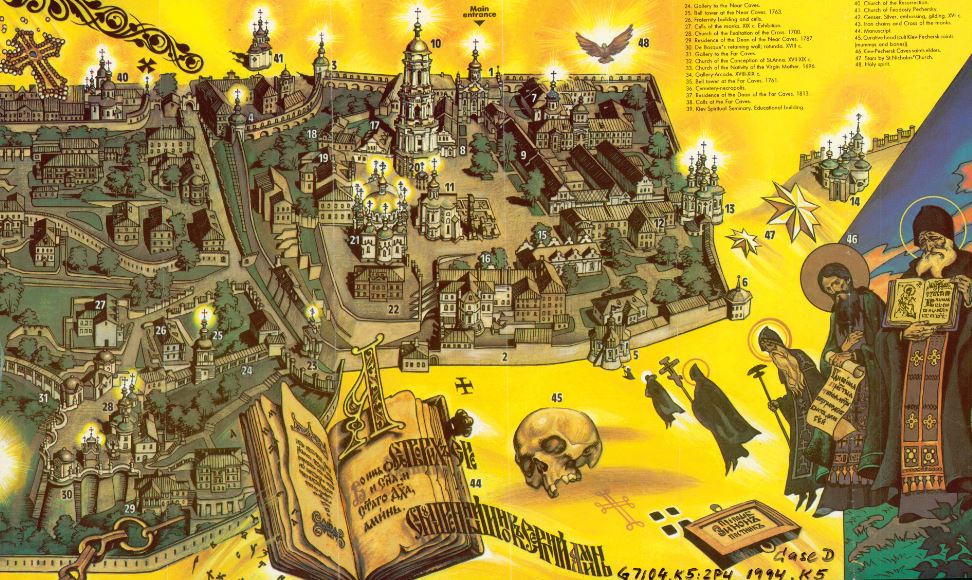
This event marks a return of the Earth Science & Map Library’s Maps and More Pop Up Exhibit Series.
Open to all audiences.
Event contact: eart@library.berkeley.edu, 510-642-2997
Access Coordinator: Susan Powell, smpowell@berkeley.edu, 510-642-2997
UC GIS Week 2022: Registration now open!
Register now for the UC GIS Week conference from Nov. 15th – 17th!
The University of California GIS Week is an opportunity for you to learn and engage with experts and mapping projects across the UC system and beyond!
This free hybrid conference is supported by the UC GIS Leadership Committee. In addition to many virtual talks and workshops, keep an eye on the schedule for in-person events happening around the UC Berkeley campus.
What a GIS & Map Librarian does all day
GIS & Map Librarian Susan Powell recently wrote a guest blog post for the non-profit Guerrilla Cartography about what she does in her work for the UC Berkeley Library. 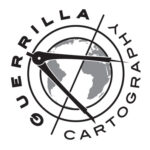 Susan also serves on the board of Guerrilla Cartography, which publishes crowd-sourced atlases. The group’s latest project, “Shelter: An Atlas,” is set to be printed later this year. Read all about “What a GIS & Map Librarian does all day” at the Guerrilla Cartography blog!
Susan also serves on the board of Guerrilla Cartography, which publishes crowd-sourced atlases. The group’s latest project, “Shelter: An Atlas,” is set to be printed later this year. Read all about “What a GIS & Map Librarian does all day” at the Guerrilla Cartography blog!
